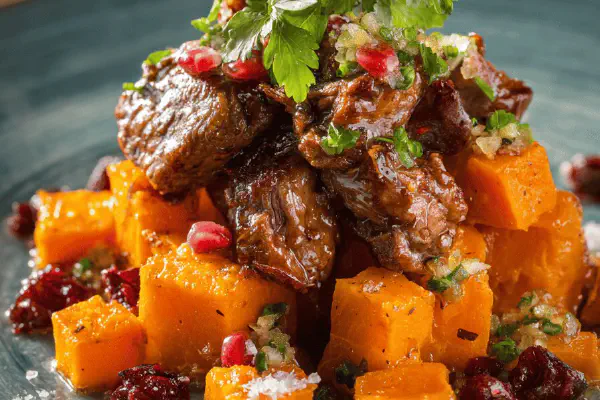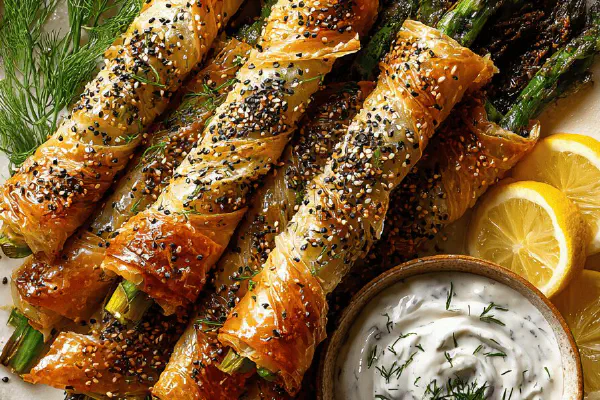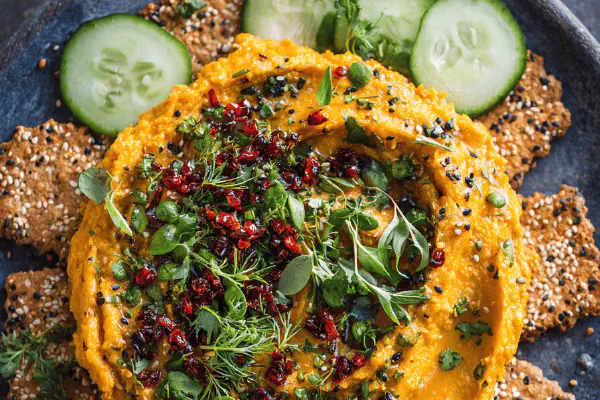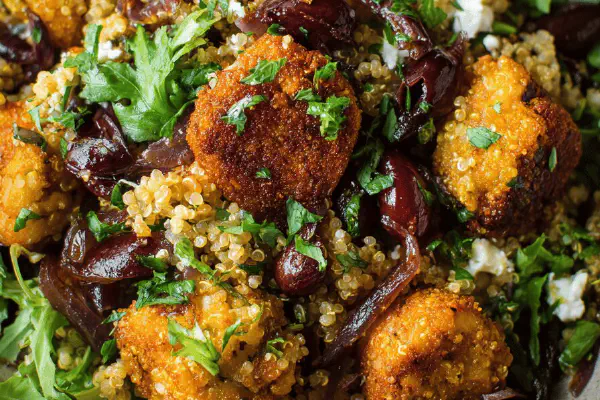Tomato Ricotta Tartlets
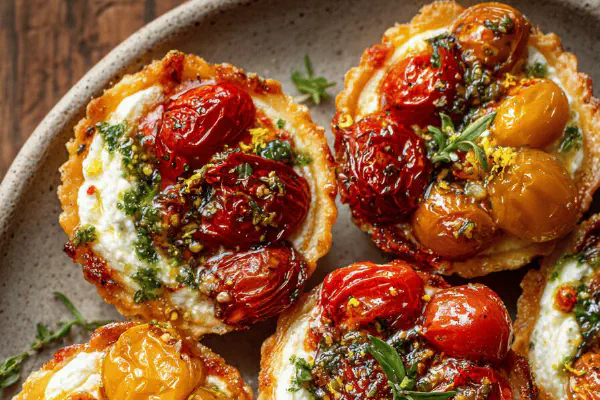
E
By Emma
Certified Culinary Professional
•
Recipe tested & approved
Crisp, golden crusts with tangy ricotta fill, topped by juicy, herb-kissed tomatoes. Balanced heat from chile flakes, zest brightness, and soft garlic. Make-ahead friendly, gluten-free, nut-free, vegetarian. Panko and olive oil replace flour; Dijon acts as binder. Oven cues & textures guide timing. Sub in burrata or labneh for ricotta. Swap mustard for miso paste if bold. Versatile, rustic finger food for casual dinners or elegant gatherings. Techniques prioritize tactile and visual signals informing doneness. Mid-apparatus cooling critical or crust sogginess ruins the bite. Simple flavors, but pay attention to ingredients’ freshness.
Prep:
30 min
Cook:
25 min
Total:
55 min
Servings:
6 servings
#French-inspired
#gluten-free
#vegetarian
#finger food
#make-ahead
Crust crisping is pivotal. Panko, oil, mustard- odd combo but nails light crunch without flour. Tang of Dijon isn’t background noise; it’s backbone. I swapped out original 1/4 cup oil for a bit less - greasiness kills crust texture in past kitchen experiments. Tomato choice matters – tried just Roma once, bland and watery. Mix of cherry and heirlooms last time gave heat and sweetness contrast. Herbs? Don’t go crazy - basil and chives mostly, thyme and oregano were subtle background props. Garlic tiny bit, raw - cuts through ricotta gently, aroma evolves while sitting. Lemon zest—don’t even think to skip. Perfect complexity, freshness. And the oven tells you everything—watch crust color shift like lava hues, and listen for hollow tap sounds. This is one to let cool fully before filling else soggy disaster.
Ingredients
Crust
- 50 ml olive oil
- 12 ml Dijon mustard
- 2 ml salt
- 1 ml red pepper flakes
- 1 egg
- 125 g panko breadcrumbs
Filling
- 250 g ricotta cheese
- 300 g small tomatoes, quartered
- 12 g chopped mixed herbs (basil, thyme, oregano, chives)
- 25 ml olive oil
- 1 small garlic clove, finely minced
- zest from 1/2 lemon
About the ingredients
Panko breadcrumbs instead of flour bulk up the crust with lighter texture; if gluten-sensitive or no panko, crushed rice crackers or gluten-free bread crumbs sub well but watch for absorption differences. Dijon mustard is small quantity but critical - it acts as glue and flavor spike. Could swap for miso paste mixed with olive oil; adds umami but salt cautiously adjusted. Oil amount slightly reduced from original tests - too much makes crust limp, too little dry. Tomatoes should be ripe but not overly juicy – cherry tomatoes preferred; if using larger ones, quarter and strain excess juice to avoid watery filling. Mixed herbs can vary - basil and chives strongest; trim others if flavor too sharp. Fresh lemon zest brightens but omit if unavailable, add splash of white wine vinegar as backup. Garlic minimal, finely minced to avoid overwhelming raw sharpness but enough for aromatic lift.
Method
Crust
- Set oven rack mid-level. Preheat oven to 175 C (345 F), slight variation helps crust browning without burning mustard sharpness.
- Whisk olive oil, Dijon, salt, chili flakes, and egg in a big bowl. Add panko, just enough to moisten. Overwet makes soggy crust, too dry falls apart.
- Divide dough; press firmly base and sides of six 10cm tart pans (greased). Thickness matters: thick crust means chewy, thin might crack. Aim for even.
- Bake 22-25 minutes. Watch for golden edges and surface becoming firm. Touch crust edge lightly; firm not soft means done. Avoid burnt mustard smell.
- Cool crusts fully on wire rack to keep crisp. Removing while warm causes steam, sog right then.
- Pop tart shells gently from pans. Place on serving plate.
Filling
- In bowl, season ricotta with salt and pepper. Mixing well helps develop gentle creaminess and spreads flavor evenly.
- Spoon ricotta into crusts, smoothing surface but don’t pack tight, keep airiness.
- Toss tomatoes with herbs, garlic, olive oil, lemon zest, salt, pepper. Let sit 5 minutes to meld flavors and soften tomatoes slightly.
- Top tartlets with tomato mixture. Juices drain into cheese, moistening without sogginess if crust properly pre-baked.
- Serve immediately or chill up to 1 hour. Warm slightly before serving for full aroma release. Raw garlic will mellow over time but can bite if too fresh.
- Optional: add toasted pine nuts or a drizzle of balsamic reduction for contrast.
Tips
- For gluten-free, panko works well; if unavailable, use crushed rice crackers or gluten-free breadcrumbs.
- Mustard adds tang and acts as binder; can swap with miso paste for umami depth but adjust salt accordingly.
- Don’t skip lemon zest; lifts tomato’s acidity, balances richness.
- Watch tomato moisture; if too watery, drain or use firmer varieties like grape or cherry.
- Cooling crust completely before filling prevents mushy shell—a mistake many make.
- Test crust doneness by tapping edge—should sound hollow and feel firm.
Cooking tips
Start oven on center rack - ensures even heat dispersal, crust browns evenly without mustard burning or egg cooking unevenly. Mix oil, dijon, salt, chili flakes, and egg thoroughly till smooth, then integrate panko - key is just enough moisture to hold together. Press crust mix evenly, not too thin to prevent cracking, not too thick to avoid doughiness; work with hands or back of spoon. Baking till golden (22-25 minutes) monitored visually and tactilely - crust edge firm and golden is how you know. Cool fully on wire rack; avoid trapping steam, which ruins crispness. For filling, seasoning ricotta before spooning spreads flavor deep into creamy cheese. Tomato mixture sits a few minutes after mixing herbs and lemon zest to soften slightly and release aroma. Add tomatoes only after crust cools or risk soggy base. Garnish generously; the mix of fresh tomatoes and herbs sings better fresh but can chill briefly; warm slightly before serving to unlock aromas. Optional additions like toasted pine nuts or drizzle balsamic raise complexity but optional. Avoid draining tomatoes too long or dish loses juiciness; balance required. Overall, watch, feel, smell, and adjust times rather than rely strictly on clocks.
Chef's notes
- 💡 Oven rack mid-level - heat spreads even. Watch crust edges brown like lava but no burnt mustard smell. Mustard sharpness burns fast if too high or close to heat.
- 💡 Mix oil, Dijon, chili flakes, salt, egg first. Then fold panko slowly - no over-wetting or crust sogs, too dry means crumbly mess. Texture matters more than exact measure.
- 💡 Press dough thick enough; less cracking, more chew. Thin means crisp but fragile, thick holds shape but can feel doughy. Press firmly; lids come off clean if crust baked fully and cool before filling.
- 💡 Touch crust edge after 22 mins. Firm, not soft means done. Do the tap-test. Hollow sound means bake longer. Crust is your timing guide more than strict clock.
- 💡 Tomatoes tossed last minute. Herbs, garlic, zest sit briefly for softness and aroma release. Do not fill hot crust - steam ruins crunch. Let crust cool on rack fully or soggy disaster.
- 💡 Ricotta seasoning ahead spreads flavor deep, keeps creaminess. Don’t pack tight when spooning; airiness important. Juices from tomato mix seep into cheese without drowning crust if done right.
- 💡 Substitute panko with crushed rice crackers or gluten-free crumbs if needed. Miso paste for Dijon adds umami punch but reduce salt carefully. Garlic finely minced - raw sharp but mellows over time in fridge.
- 💡 If tomatoes watery, drain or pick firmer grape varieties. Avoid over-draining or mix loses essential juiciness. Lemons zest critical; if unavailable, white wine vinegar splash possible but different finish.
Common questions
How to know crust is done?
Tap edges gently - firm and hollow sound. Look for golden color near pan edges. Smell absence of burnt mustard sharpness. Oven temps vary - don’t rely only on clock.
Can I replace ricotta?
Burrata or labneh swaps well. Burrata adds creamier mouthfeel; labneh more tang. Adjust seasoning a bit because textures differ. Fills differently, so fill gently to keep air.
What if crust soggy after filling?
Cool crust fully before adding filling. Hot crust traps steam, sogs asap. Overwet dough makes base soft too. Cooling on wire rack stops trapped moisture. Re-bake crust if needed.
How to store leftovers?
Chill tartlets in airtight container, separate tomatoes if possible to keep crust crisp. Serve slightly warm or room temp for texture. Avoid long fridge time or garlic sharpness grows.
